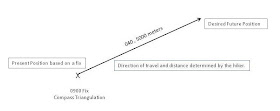Do you carry a back-up compass when you leave the trail head? How accurate is it? This post discusses what your options are.
Frequently in my backcountry land navigation class, I am
asked about the need to carry a back-up compass. Generally students are interested in a light
weight model that is low in cost, small in size, and would “fill in” as needed.
I purposefully evaluated several models many consider to
be back-up options. When choosing a
back-up magnetic compass, the hiker must ask himself “What are my
priorities? Is it accuracy?
Reliability? Cost? Size and weight?”
Different models bring different values to the
outdoorsman. If the primary compass got crushed, misplaced,
or stopped working what model would serve as a back-up to get out of the woods
safely? Generally a back-up compass
isn’t as capable as the primary. People
want to cut back on weight and expense.
For this evaluation, I
selected five commonly used compass models. They are: the Brunton 9020G, a wrist watch
compass “The Navigator” (sold by Country Comm), the Silva Type 3, the Silva
Type 7, and a ball compass by Outdoor Product (not Outdoor Research.)
I will compare the five selected back-up units
to the highly regarded Silva Ranger (CL 515) and Brunton 8010G base plate compasses
to establish a bearing standard. The Silva ranger and 8010G models are oriented
to magnetic north as shown below:
Figure 1 The Silva Ranger (left) and the Brunton
8010G (right.)
Neither the Silva Ranger nor Brunton 8010G are adjusted
for declination for this review. This provides a consistent baseline for
evaluation purposes.
To begin the comparison of the back-up compass models, I
chose to define them in the categories of (1) reliability (2) accuracy and
readability (3) cost and (4) size and weight.
Reliability:
I picked up each
back-up compass model option and turned it in place rotating the compass and
magnetic needle. I then stopped and set it on a flat surface
oriented to magnetic north. I quickly
found that the Brunton 9020G, and the Silva type 3 and 7 settled quickly and
matched the bearing of the standards. The
compass needles quickly aligned to magnetic north and required little movement
on my part to stabilize the compass.
The ball and wristwatch compasses were extremely
finicky. Both models required time and
manipulation (moving the compass housing side to side, up and down) to get them
to align to magnetic north. Both
required what I consider to be excessive movement to level the housing to allow
the needle or ball to swing freely. This
was especially true of the ball compass; frustrating.
Figure 2 Compasses
from left to right: The Brunton 9010G, The Navigator, Outdoor Product ball
compass, Silva type 7 and type 3. Note
that the five compasses close proximity to each other cause the magnetic
needles pointing in different directions.
Accuracy and readability:
I then checked the compasses for their alignment to
magnetic north. All models were in general
agreement but the three baseplate compasses ( Brunton 9020G, Silva Type 3,
Silva Type 7) allowed for a more accurate reading with 2° increments marked on
the rotating dial. Further, each baseplate
compass could be used for sighting on a distant object to triangulate the hiker’s
position.
The ball compass and the watch compass did not provide
for accurate measurement; they just aren’t built for that. The Navigator has increment tick marks every
10° and the ball compass is marked every 15°.
That said, both will provide a trend of direction. Knowingly choosing a
trend of direction verses specific bearing accuracy is a critical choice for
the outdoorsman when selecting a back-up compass model. The impact of providing a trend of direction
is that these compasses will indicate that the hiker is moving in a generally
northerly direction as opposed to hiking along a bearing of 350°.
Cost:
The most affordable are the ball compass ($2.00) and the
Navigator (under $5.00). The three
baseplate models range from $10 to $12.
Size and Weight:
The wrist watch Navigator is the most compact and is read
quickly. Having a compass on the wrist
takes a bit getting used to; it’s just different. The ball compass is most frequently worn on
the exterior of a jacket or on a pack’s web gear. Both are quickly accessible and are feather
light.
The Brunton 9020G is the largest of the group. That said, all three baseplate compasses fit
easily in a shirt pocket.
Size and weight is of minimal concern for all five
models.
The ball compass and Navigator are fine for short day
hikes. Both are good choices as an
introductory model and get young people interested in navigation early.
For serious backcountry adventures I’d opt for one of the
baseplate models. The 9020G's ability to
adjust for declination is a big plus for me.
The baseplate models are the natural progression for learning the finer
points of compass navigation.







